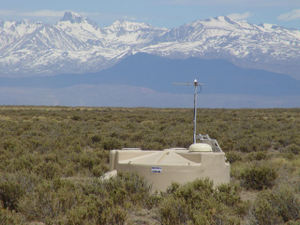Cosmic rays are protons or whole atomic nuclei that have been flung into space to travel at near the speed of light. They come in different varieties, with low- and medium-energy rays produced by exploding stars, or even by our own sun.

|
| ©Pierre Auger Observatory |
| One of the Pierre Auger Observatory's 1600 surface detectors, water tanks that detect particles from cosmic ray air showers. |
But the extraordinarily high-energy rays have been a mystery. Some move so quickly as to give them fully 100 million times the energy of anything produced by the most powerful particle accelerators on Earth. The most energetic one ever observed, in 1991, would have felt like a major-league fastball if it had managed to penetrate the atmosphere and hit someone in the head.
Luckily for us, these cosmic rays tend to strike other atoms in the atmosphere, creating instead showers of particles that fall over a space as wide as 15 square miles.
The team of scientists using the Pierre Auger Observatory in Argentina, the largest cosmic ray observatory on the planet, have observed a set of 27 of the highest energy rays. The most powerful of these can be tracked backwards with a fair amount of precision, a little like tracing a sniper's bullet back to its original source.
They found that the paths of these high-energy rays were highly correlated with galaxies that have so-called Active Galactic Nuclei, or massive black holes that are throwing out unusual amounts of particles and energy while they consume dust, gas and other material. Most galaxies are believed to contain black holes, but not all are of this prodigious type.
The precise way these formations can accelerate particles to such incredible energies is still unknown. But it now looks like they're the culprits. Says University of Chicago Nobel Prize Winner James Cronin, who helped create the Auger Observatory:
"This is a fundamental discovery. The age of cosmic-ray astronomy has arrived. In the next few years our data will permit us to identify the exact sources of these cosmic rays and how they accelerate these particles."A paper describing the results is being published in the Nov. 9 issue of Science.



Reader Comments
to our Newsletter